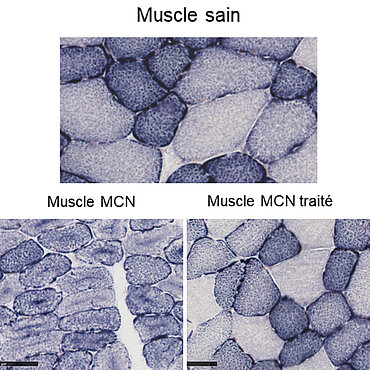Centronuclear myopathies: proof of concept for a single-dose treatment
Centronuclear myopathies are rare genetic diseases characterized by muscle weakness that can lead to breathing difficulties, and for which there is no treatment. In this article published in Brain, scientists from the Laporte team characterize the effects of a gene therapy to increase muscle fiber size, restore muscle strength and establish a treatment approach to be explored.

Centronuclear myopathies are highly disabling genetic diseases characterized by the abnormal position of the cell nucleus within muscle fibers. Several genes have been identified as being involved in these diseases, such as MTM1 and BIN1. However, the function of these genes in muscle cells has not been elucidated, and there is currently no treatment available for centronuclear myopathies.
In this article, scientists describe the use of modified viruses as vectors to increase MTM1 gene expression in the muscle cells of mice suffering from centronuclear myopathies, due to mutation of the BIN1 gene. After a single injection just after birth, the mice did not develop the characteristic signs of the disease, such as reduced activity, muscle weakness coupled with atrophy, and structural abnormalities within the muscle fibers. This treatment prevents the onset of the disease. By treating the mice after the onset of symptoms, the scientists also observed an increase in muscle mass and a reduction in structural abnormalities, validating the curative effect of this approach. This study demonstrates that centronuclear myopathies linked to a defect in one gene (BIN1) could be treated using another gene (MTM1).
The results shed light on the function of the genes causing centronuclear myopathies, and pave the way for the development of a treatment for these crippling diseases.

Summary diagram of treatment strategies. In the absence of treatment, Bin1 mutant mice develop centronuclear myopathy (CNM) during growth. By increasing MTM1 gene expression using a viral vector, the disease can be prevented or partially reversed.
Credit: Quentin Giraud, IGBMC
